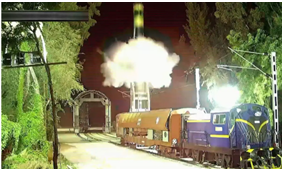

26th September 2025 (13 Topics)
Context:
The Defense Research and Development Organisation (DRDO) successfully test-fired the Agni-P missile from a rail-based mobile launcher, placing India among a select group of nations with such capabilities.
Significance of Rail-Based Launchers

- Strategic deterrence: Provides survivable second-strike capability in case of a nuclear attack.
- Mobility advantage: Launchers can move across India’s 70,000 km rail network, making detection difficult.
- Concealment: Can be hidden in tunnels, forests, or stations, complicating enemy surveillance.
Global Context
- Only a few countries (Russia, US, China) had previously demonstrated capability of launching long-range ballistic missiles from rail-based platforms.
- India’s inclusion strengthens its strategic position in global nuclear deterrence architecture.
Vulnerabilities of Fixed Launch Systems
- Silos and stationary platforms are vulnerable to precision strikes due to advances in satellite imagery, missile accuracy, and surveillance technologies.
- Mobile launchers offer higher survivability by complicating enemy targeting.
Agni-P Missile Characteristics
- Successor to Agni-I and Agni-II
- Medium-range ballistic missile (MRBM) with range of 1,000–2,000 km.
- Capable of carrying both conventional and nuclear warheads.
- Lighter, more agile, and equipped with advanced navigation and guidance compared to earlier Agni series.
Strategic Implications for India
- Enhances India’s credible minimum deterrence under the No-First Use (NFU) policy.
- Provides flexibility and redundancy in deployment strategies.
- Complements submarine-launched ballistic missiles (SLBMs), giving India land-sea dual survivability options.
- Adds resilience to India’s nuclear triad (land, air, sea delivery systems).
More Articles


